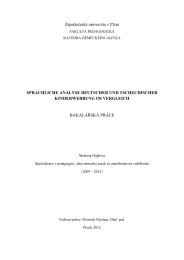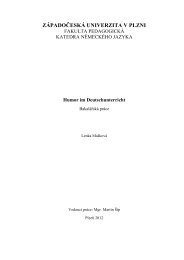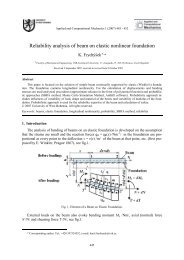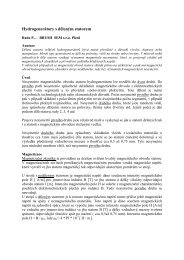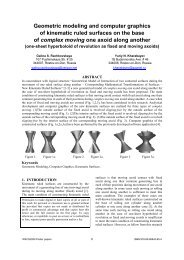POSTER: Effective Object Sorting Technique for Developing 3D GUI ...
POSTER: Effective Object Sorting Technique for Developing 3D GUI ...
POSTER: Effective Object Sorting Technique for Developing 3D GUI ...
You also want an ePaper? Increase the reach of your titles
YUMPU automatically turns print PDFs into web optimized ePapers that Google loves.
<strong>POSTER</strong>: <strong>Effective</strong> <strong>Object</strong> <strong>Sorting</strong> <strong>Technique</strong> <strong>for</strong><strong>Developing</strong> <strong>3D</strong> <strong>GUI</strong> Including Translucent <strong>Object</strong>sByungkwon KangSamsung Electronics416, Maetan-<strong>3D</strong>ong, Yeongtong-Gu,443-742, Suwon-city, Gyeonggi-Do, Koreabk76.kang@samsung.comSunghee ChoSamsung Electronics416, Maetan-<strong>3D</strong>ong, Yeongtong-Gu,443-742, Suwon-city, Gyeonggi-Do, Koreashane.cho@samsung.comABSTRACTIn developing a user interface, it is very important to provide usability, intuitiveness and convenience. Toaccomplish these factors, <strong>3D</strong> user interface can be one good solution. Recently, many kinds of embeddeddevices have been developed and utilized <strong>for</strong> various areas of human life; <strong>for</strong> example, Digital TVs, gameconsoles, MP3 players, etc. A <strong>GUI</strong> makes these devices easier to use and more effective. But, their poorhardware per<strong>for</strong>mances often prevent developing a high quality visual effect on their <strong>GUI</strong>s. A visual effect usingalpha blended object is one of the typical examples of this kind that limits the development of <strong>3D</strong> applicationson an embedded hardware. In this paper, we propose an effective object sorting technique that can be used todevelop a <strong>3D</strong> <strong>GUI</strong> including many translucent objects.Keywords<strong>3D</strong> graphics, <strong>3D</strong> <strong>GUI</strong>, Real-time rendering, Alpha blending, <strong>Object</strong> sorting, Translucent object.1. INTRODUCTIONAlpha blending is a very useful technique that canbe utilized in various areas of <strong>3D</strong> graphics in order togenerate more elegant visual effects. To compositecolors of several translucent objects naturally, notonly the rule <strong>for</strong> color composition but also the orderof compositing objects must be selected carefully.These days, <strong>3D</strong> graphics APIs such as OpenGL andDirect<strong>3D</strong> support blending of translucent objects’colors by using alpha channels very well. But, depthsorting which determines the order of composition<strong>for</strong> accurate blending of colors is not supported oncurrent graphics hardware and APIs. There<strong>for</strong>e, aneffective sorting technique <strong>for</strong> correct composition ofcolors in an order of objects’ distances isindispensable to high quality <strong>3D</strong> graphics.In this paper, we propose an effective object sortingtechnique that can be utilized <strong>for</strong> developing a <strong>3D</strong><strong>GUI</strong> including many translucent objects. Indesigning this technique, we defined somerestrictions and conditions that are often found inPermission to make digital or hard copies of all or part ofthis work <strong>for</strong> personal or classroom use is granted withoutfee provided that copies are not made or distributed <strong>for</strong>profit or commercial advantage and that copies bear thisnotice and the full citation on the first page. To copyotherwise, or republish, to post on servers or to redistributeto lists, requires prior specific permission and/or a fee.Copyright UNION Agency – Science Press, Plzen, CzechRepublic.developing a <strong>3D</strong> <strong>GUI</strong>. These factors are very usefulto simplify the method of determining spatialrelations between <strong>3D</strong> objects.This paper is organized as follows. First, in Chapter2, we introduce previous works about depth sortingmethods and in Chapter 3, we summarize thepreconditions and restrictions that are often found indeveloping <strong>3D</strong> <strong>GUI</strong>s including translucent objects. InChapter 4, we describe our depth sorting techniqueand summarize the per<strong>for</strong>mance and effectiveness inChapter 5. Finally, we conclude this research inChapter 6.2. RELATED WORKDepth ordering of <strong>3D</strong> objects is a classic problem invarious areas of computer graphics. There have beenmany types of research done to sort the primitives inobject space [SBGS69, NNS72]. But theirper<strong>for</strong>mances largely depended on the number ofobjects to be used. There<strong>for</strong>e, there were manyattempts to avoid the dependency on the number ofobjects [SBM94, KLNR97, SL98, WMS98, BOS04].If the spatial positions of objects or polygons arenot changed, a space partitioning data structure canbe the most effective solution <strong>for</strong> ordering <strong>3D</strong> objects.A binary space partition (BSP) of a set of objects is arecursive convex subdivision of space. It wasdesigned to compute a visibility order amongpolygonal primitives used in graphics applications byWSCG2008 Poster papers 13 ISBN 978-80-86943-17-6
Finding front-back objectFor each object which is overlapping with otherobjects, the spatial relation with the overlappedobject must be discerned. To make an accurate alphablended result, we must find which object isoccluding the other object carefully and exactly. Inthis paper, we propose a simple and effectivetechnique to find the spatial relation betweenoverlapped objects based on the preconditions andrestrictions described in Chapter 3.This technique is based on the restriction that allboundboxes must be shaped as a rectangularparallelepiped. From this restriction, we candetermine the spatial relation between two boxes byfinding the number of planes that all vertices ofanother object are placed in front of it. There are 3cases between 2 non-intersecting boundboxes.a. A places in front of only 1 plane of B.b. A places in front of 2 or 3 planes of B.c. There is no plane that A places in front of it.Let’s consider the first case. In this case, asillustrated in Figure 3, we can decide which object isthe front object by discerning the spatial position ofview point related to the selected plane. As illustratedin Figure 3(a), when the view point is placed in frontof the plane, object A is placed in front of object B.Otherwise, when the view point is behind the planeas see in Figure 3(b), object B becomes the frontobject.a) front case b) behind caseFigure 3. Spatial relation between selected plane andcamera.In cases except the first case, it is difficult to findfront or back objects by using only 1 plane. But it ispossible to find nearer object by comparing thenearest distances of vertices because the two objectsare explicitly overlapped in the view of camera. Afterfinding front and back objects between overlappedobject pair, the front object is inserted to the front listof the back object and the back object is inserted tothe back-list of the front object.Rendering the objects in correct orderAfter front-back relations of all overlapped objectpairs are discerned, the rendering order can bedecided by using the result of discrimination. Thisprocess is per<strong>for</strong>med based on a simple rule that anyobject cannot be rendered be<strong>for</strong>e its back-listbecomes empty.First of all, find an object having an empty back-list.The fact that an object has an empty back-list meansthe objects can be rendered immediately becausethere are no objects covered by the current object.The found object is inserted to the rendering queueand deleted from the back-list of its all front objects.If one of the front objects has an empty back-list, theobject becomes a renderable object that can berendered immediately. And then, the previousprocess is recursively per<strong>for</strong>med in order to removethe newly selected object from the other object’sback-list again. After finish this process <strong>for</strong> all objectin the scene, the remaining objects which are notinserted yet are the non-overlapped objects. So theseobjects can be rendered without any ordering process.5. EXPERIMENTS AND RESULTSTo verify the per<strong>for</strong>mance and effectiveness of outtechnique, we per<strong>for</strong>med several test on a desktop PCwith a 2.13 GHz Intel Core2Duo CPU and 1 GBRAM. To test the per<strong>for</strong>mance, we generated randomnumbers of boxes and panels that are not intersectedwith any other boxes.Table 1 shows the statistics of results ofimplemented applications using the proposed sortingtechnique. The test was done using several numbersof randomly-generated parallelopipedons and parallelpanels. In Figure 4 and 5, we illustrated the results ofrendered image under standard OpenGL environment.Figure 4 shows the comparison of not blended,incorrectly blended and correctly blended images.Figure 5 precisely shows the difference betweencorrectly and incorrectly rendered results. As shownin Figure 5(b), the overlapped objects can becorrectly rendered by using sorting techniqueproposed in this paper. In Table 1, we summarizedthe per<strong>for</strong>mances <strong>for</strong> 100 or 300 numbers of objectsand we illustrated the per<strong>for</strong>mance <strong>for</strong> all number weconsidered in figure 6.6. CONCLUSIONSIn this paper, we proposed a new depth sortingtechnique <strong>for</strong> accurate and fast alpha blending <strong>for</strong>developing <strong>3D</strong> <strong>GUI</strong>s. In this technique, we designedseveral effective techniques to construct a projected2D polygon from a boundbox and to determine thespatial relation between overlapped <strong>3D</strong> objects. Theproposed sorting technique is very easy to implementand it is possible to quickly arrange the depth orderof each object.WSCG2008 Poster papers 15 ISBN 978-80-86943-17-6
a) without alpha blending b) blended without depth sorting c) correct result with depth sortingFigure 4. Comparison of the correct and incorrect alpha blended results using 100 random boxes.Although this technique is able to calculate thedepth orders very quickly, the restrictions make itdifficult to apply our technique <strong>for</strong> some applicationareas. In spite of the restrictions, this technique canbe applied to various <strong>3D</strong> applications in a limitedhardware environment if there is not enoughhardware per<strong>for</strong>mance.a) incorrectly blended result b) correctly blended resultFigure 5. Comparison of the correct and incorrect alphablended result using 100 parallel panels.Figure 6. Rendering per<strong>for</strong>mance of proposed sortingtechnique <strong>for</strong> parallel panels.Random 100boxesParallel 100panelsParallel 300panelsMean 293.5 fps 396.3 fps 55.3 fpsBest 1651.2 fps 476.3 fps 62.8 fpsWorst 95.9 fps 209.4 fps 49.6 fpsTable 1. Rendering statistics.7. REFERENCES[AGMV97] Agarwal P. K., Guibas L. J., Murai T. M.and Vitter J. S., Cylindrical static and kinetic binaryspace partitions. In ACM Symposium onComputational Geometry, pp. 39-48, 1997.[BOS04]. Berg M., Overmars M. and SchwarzkopfO., Computing and verifying depth orders. InSICOMP, pp. 437-446, 2004.[FDFH96] Foley J. D., Dam A., Feiner S. K. andHughes J. H., Computer Graphics : Principles andPractice, 2nd edition, Addison-Wesley, 1996.[HKN80] Huchs H., Kedem Z. and Naylor B., Onvisible surface generation by a priori tree structures.In Proc. of ACM SIGGRAPH, Vol. 14, No. 3, pp.124-133, 1980.[KLNR97] Karasick M. S., Lieber D., Nackman L. R.and Rajan V. T., Visualization of three-dimensionaldelaunay meshes. Algorithmica, Vol. 19, No. 1-2, pp.114-128, 1997.[NNS72] Newell M. E., Newell R.G. and Sancha T.L. A solution to the hidden surface problem. In Proc.of ACM Nat. Mtg., 1972.[SBGS69] Schumacker R., Brand B., Gilliland M.and Sharp W., Study <strong>for</strong> applying computergeneratedimages to visual generation. AFHRL-TR-69-74, US Air Force Human Resources Lab, Tech.Rep., 1969.[SBM94] Stein C., Becker B. and Max N., <strong>Sorting</strong>and hardware assisted rendering <strong>for</strong> volumevisualization. In Symposium on Volume Visualization,pp. 83-90, 1994.[SL98] Snyder J. and Lengyel J., Visibility sortingand compositing without splitting <strong>for</strong> image layerdecompositions. In Proc. of ACM SIGGRAPH, pp.219-230, 1998.[Tor90] Torres E., Optimization of the binary spacepartition algorithm (BSP) <strong>for</strong> the visualization ofdynamic scenes. In Proc. of Eurographics ’90, pp.507-518, 1990.[WMS98] Williams P. L., Max N. and Stein C., Ahigh accuracy volume renderer <strong>for</strong> unstructured data.IEEE Trans. on Visualization and ComputerGraphics, pp. 1-18, 1998WSCG2008 Poster papers 16 ISBN 978-80-86943-17-6




